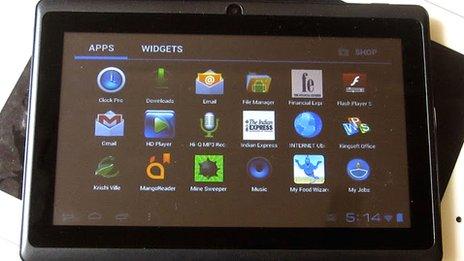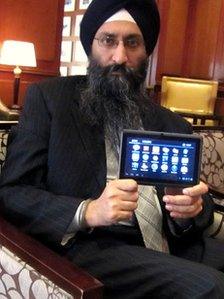Tablet computer: Aakash upgrade in India 'well received'
- Published

The Aakash 2 is made by UK-based company Datawind
Technology writer Prasanto K Roy tests the upgraded version of the world's cheapest tablet computer Aakash 2 and discovers a significantly improved product.
The world's cheapest tablet computer, Aakash 2, has risen from the ashes and is poised to take advantage of India's target that all its 220 million students should have a tablet in the next seven years.
Unlike the much-panned first version version launched a year ago, the new Aakash - which means sky - is very usable. It's slim, smart and light, and performs well.
Launched on 12 November by India's president, Aakash 2 will be sold via the government to college students at a remarkable 1,130 rupees ($21, £13) per unit, thanks to a waiver of customs and other duties and a 50% subsidy.
Without those concessions, its identical commercial twin, the UbiSlate 7Ci, sells online for $78. It has company in India at that price: the BSNL Penta IS709C tablet, with similar specs. There are others in the $80-90 range.
Big improvements
Designed by London-based Datawind, the Aakash 2 is assembled in India. (Custom kits for initial batches have been sourced from China.) Datawind is owned and run by Canadian Sikh brothers Suneet and Raja Tuli, and has its design and research labs in Montreal, Canada.
The tablets are then supplied to top engineering school, IIT Mumbai, which tests and distributes them under a special programme funded by India's Human Resource Development Ministry.
After using a pre-release version of the tablet for three months, and the shipping product for a week, I found big improvements in both hardware and software.
Aakash 2 runs Ice Cream Sandwich, Google's Android 4.0 operating system. Also new is access to the search firm's Play Store, which lets users choose from thousands of apps.
This compact tablet has a 7in (17.8cm) display and, at 292 grams (0.6lb), is lighter than the iPad Mini and Nexus 7.
The BBC's Rajini Vaidyanathan looks at the latest Aakash with Prof Phatak
The design is minimalist: no buttons up front, nothing but a front-facing VGA camera that's fine for video chats, but gives you terrible still photos.
The Aakash 2 now uses a capacitive multi-touch display, and a 1 GHz Cortex A8 processor that's three times faster, making touch and apps more responsive.
Memory and storage have been doubled, to 512 MB RAM and 4 GB flash, respectively.
Performance lives up to budget tablet norms.
In our tests, we found graphics and browsing speeds similar to others in its class, but lower than tablets above the $100 mark.
By contrast, the $199 Nexus 7 is about 25% faster for graphics, and twice as fast as the Aakash for web browsing.
The Aakash's battery lasted nearly four hours with video streamed on wi-fi, living up to Datawind's claim.
This is still a bit low for students without desktop power outlets, but impressive for this price, size and weight.
Datawind is fulfilling an order for 100,000 Aakash 2 tablets.
A new government tender is expected by January 2013 for five million units, with "up to a million" units targeted by March, according to Datawind chief executive Suneet Tuli. The government may appoint multiple suppliers for this next order.
Infrastructure concerns
Datawind will compete, and expects a cost edge because of its volumes and sourcing.
The company makes its own touch panels in Montreal, and will soon do so in a new fabrication centre in Amritsar, India.
Interest in the low-cost tablet has been exceptional, with Datawind claiming four million pre-orders online.

Datawind chief Suneet Tuli promises faster deliveries
While internet forums and social media are full of complaints of non-receipt of the product by those who ordered, Mr Tuli says that the 1% or so who paid up while ordering have been sent their products.
Datawind is now promising a 48-hour shipment on pre-paid orders, and claims 3,000 deliveries a day, going up by to over 7,000 a day by the end of the year.
Despite critical acclaim for the Aakash 2, the jury's still out on the programme, because of three crucial elements.
First, supply issues accompanying the decision to manufacture in India have continued.
Datawind is ramping up by initially contracting Chinese manufacturers to supply custom kits, and assembling them in Amritsar, a city in Punjab. It has also appointed four contract manufacturers in India. This may not be enough.
Second, the hardware is only one piece of the puzzle. The curriculum-linked content isn't in place to support a massive ramp-up in colleges and schools. Training the teachers will be an enormous task once the programme ramps up beyond the initial 100,000 units to engineering colleges.
And finally, schools and colleges do not have infrastructure, especially power, and power outlets. Even with a four-hour battery life, power outlets will be a practical necessity.
But, for now, Datawind has fixed the Aakash hardware, delivering a capable tablet at a world-beating price.
Its real work is ahead: to ramp up deliveries while maintaining quality, and to keep its edge amidst growing competition.
And the government's real work is ahead, too: to push through its ambitious $10bn program to give a tablet to every student.
Prasanto K Roy (@prasanto on Twitter) is editorial advisor at CyberMedia India
- Published25 June 2012
- Published25 June 2012
- Published15 October 2011
- Published5 October 2011
- Published23 July 2010